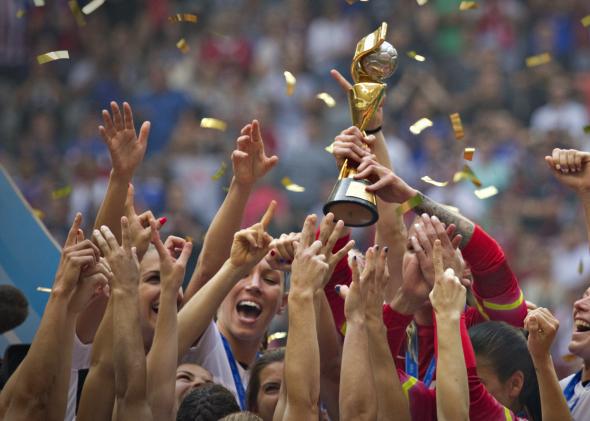Sunday’s World Cup final had everything—Carli Lloyd scored an amazing hat-trick, a jubilant Abby Wambach embraced her wife, 1999 champion Christie Rampone made what will be her last World Cup appearance, and the Americans brought home the prize that the United States has been after for 16 years with an amazing 5–2 victory over Japan.
Well almost everything: The number of sponsors for the Women’s World Cup was noticeably low. With the news of record ratings for the final, possible sponsors and corporations are likely kicking themselves for the missed opportunity. Had they advertised on Fox, they would have reached the estimated 25.4 million viewers of Sunday’s game—more than the final game of last year’s World Series, more than the average number for this year’s NBA and NHL finals, and more than any single men’s World Cup broadcast in history.
During the monthlong tournament, Fox and its sports networks showed ads from more than 20 sponsors, including Nationwide Insurance and Fiat.
While the network’s revenue was three times that of the 2011 Women’s World Cup, it is nowhere near sponsorship during the men’s games. The Washington Post reports:
Fox grabbed an estimated $17 million in ads from corporate sponsors of the elite women’s matches—a tiny fraction compared to the $529 million ESPN pocketed in sponsorship revenue from last year’s tournament in Brazil.
…
[C]ompanies that invested exhaustively in ad blitzes and social media around last year’s tournament, like Adidas, proved staggeringly quiet during the Women’s World Cup.
The discrepancy is equal parts capitalist and sexist. With two 45-minute halves and a lack of constant commercial breaks, it’s true that soccer doesn’t lend itself as easily to advertising spectacle as the American favorite of football. Still, that doesn’t explain why the women’s final—seen by more people than the men’s—didn’t get the sponsorship respect it deserved.
Even though the the U.S. women’s national team has repeatedly surpassed the stature of the men’s—let’s not forget that Abby Wambach holds the record for most international goals scored—TV sponsors apparently still aren’t over the underlying assumption that women’s soccer won’t garner the attention that the men’s tournament does, and is therefore not worth spending money on.
This World Cup in particular was marked by other disparities, with the women’s teams forced to play on artificial turf. The most frustrating disparity might not even be TV sponsorships, but rather prize money: FIFA will award the U.S. only $2 million, compared with the $35 million that the German’s men team received for winning the 2014 Cup.
While TV sponsors are clearly lagging behind the audiences for the Women’s World Cup and FIFA is taking advantage of that lag to undercut the athletes on the field, this year’s record viewing shows that they can’t keep getting away with it for long without losing out on some serious cash.
